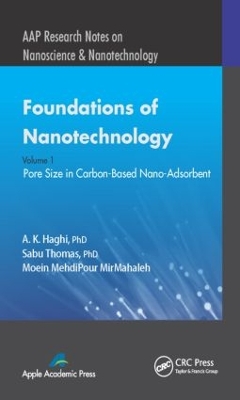AAP Research Notes on Nanoscience and Nanotechnology
2 total works
Foundations of Nanotechnology, Volume Two
by Sabu Thomas, Saeedeh Rafiei, and Shima Maghsoodlou
Foundations of Nanotechnology, Volume One
by A. K. Haghi, Sabu Thomas, and Moein MehdiPour MirMahaleh
This volume covers a wide range of adsorption activities of porous carbon (PC), CNTs, and carbon nano structures that have been employed so far for the removal of various pollutants from water, wastewater, and organic compounds. The low cost, high efficiency, simplicity, and ease in the upscaling of adsorption processes using PC make the adsorption technique attractive for the removal and recovery of organic compounds. The activated carbon modification process has also been of interest to overcome some of the limitations of the adsorbents.
Due to a large specific surface area, and small, hollow, and layered structures, CNTs and carbon nano structures have been investigated as promising adsorbents for various metal ions. Inorganic and organic pollutants can be easily modified by chemical treatment to increase their adsorption capacity. There is the huge hope that nanotubes applications will lead to a cleaner and healthier environment. A brief summary of these modeling methods is reviewed in this volume.
Also, two important simulation methods, the Monte Carlo and the Molecular Dynamic, are included in this volume. The presence of micro and mesopores is essential for many researchers aiming to control micro or mesoporosity. The present volume attempts to give a general view of the recent activities on the study of pore structure control, with application novel simulation and modeling methods and the necessity and importance of this controlling. This volume also provides a brief overview of the methodology and modeling beside simulation methods for characterization of nanoporous carbons by using adsorption isotherm parameters.

